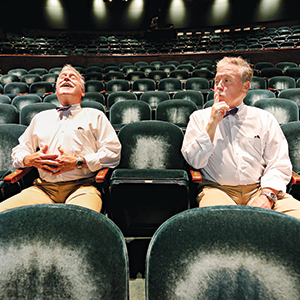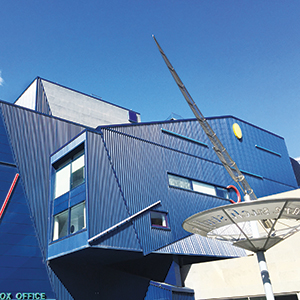Fall Arts 2017
Fall Arts: Return of the Hammer
the valley's performing arts alive
Intro | Music | Classical | Art | Theatre | Film | Hammer Theatre Center
 Chris Burrill sees a bright future for San Jose arts and the Hammer Theatre Center.
Chris Burrill sees a bright future for San Jose arts and the Hammer Theatre Center.
Chris Burrill squints into the midday sun as he surveys downtown San Jose from the fourth-floor terrace of the Hammer Theatre Center. In the distance—to the northwest, not far beyond the iconic Renaissance Revival tower of the Bank of Italy Building—he points to three massive cranes rising above the city.
All three, he notes, are part of new residential projects. Though some in the arts community view luxury apartments and condos as a harbinger of gentrification and a threat to the creative class, Burrill—who was brought on as executive managing director of the Hammer after San Jose State University (SJSU) took over management of the building in 2016—sees the future residents as prospective patrons.
"We're surrounded by people," he says.
This, coupled with the prospect of a new Google campus and the planned Adobe expansion, gives Burrill hope that a growing population base will support Hammer's offerings.
"San Jose seems to be in a really great place right now," he says.
Disastrous Past
It's hard to imagine anyone was so optimistic about Susan and Phil Hammer Theatre Center back in June of 2014—the year the San Jose Repertory Theatre went bankrupt and abruptly pulled out of the big blue complex in the middle of their season, just days before the scheduled opening of Landscape With Weapon by Joe Penhall.
In retrospect, the Rep's closure was long foreshadowed. The city of San Jose, which owns the building, had bailed the theater company out before, and the troupe had been struggling financially for years before filing for Chapter 7 in 2014. Still, the theater's shuttering sent shockwaves through the local arts community.
"When the San Jose Rep closed down, that was devastating for everybody here," says Larry Hancock, executive director of Opera San Jose. Hancock remembers how the Rep and Silicon Valley Ballet closed in quick succession. "Those were dark days. It seemed like it was heralding a very difficult time."
The mood was quite different in 1997, when the repertory theater building opened. Silicon Valley theatergoers and industry insiders were equally excited. "It was jubilation everywhere," Hancock recalls. "Everybody benefited from that—across the board."
When the Hammer came online, it gave downtown San Jose a second midsize venue similar in capacity to Montgomery Theater, then home to Children's Musical Theater, Opera San Jose and the Rep new.
It didn't take long for issues to pile up. Timing was an issue. The dot-com crash of 1999 came just two years after the building opened. And the Great Recession was just kicking off when the city decided to pony up $60,000 to rechristen the center. In 2007, the Redevelopment Agency, kicked in an additional installed "Susan and Phil Hammer Theatre Center" sign in recognition of San Jose's former mayor, Susan Hammer, and her husband, who were instrumental in developing the property.
Then there was Timothy Near, who served as the company's artistic director for 20 years. She was criticized as setting herself apart from the community and pursuing her own artistic vision at the expense of producing more digestible programming.
The building itself had problems. The elevators suffered from mechanical issues and were insufficient for carrying large numbers of people. Basic maintenance stacked up. And from the jump, it was compared to a Dumpster by critics of its brutally modern design—that was before the brightly colored shapes and lights were added in hackneyed attempt to soften the structure's visual aesthetic.
It didn't come cheap. The original cost was $31.8 million—with $28.5 million coming from the San Jose Redevelopment Agency and $3.2 million coming from The Rep. The rechristening of the center cost taxpayers money as well.
Hancock can sympathize. "Turning on the lights, the air conditioner or the heater in a theater is hugely expensive—and keeping the roof from leaking and repairing the boiler," he says, recalling that the Rep operated without heat for a stretch, because they couldn't afford to fix the system.
By the time San Jose Repertory Theatre collapsed, the building was nearly 20 years old and in poor repair.
Cause for Hope
In many ways, Anthony Sutton came of age at the Hammer. The San Jose native was just 10 years old when the building opened its doors, and the theater arts professional has many fond memories of attending productions and even performing in the space.
A graduate of Lincoln High School, Sutton now works as the technical production manager for the Hammer Theatre Center—a role he takes great pride in, as it gives him the opportunity to help "breathe new life into" a place he grew up viewing as the pinnacle of South Bay theater.
"I feel very empowered," Sutton says. "I've been charged with making this space everything I think it could be." He is convinced that the Hammer will soon be the "most technically sophisticated and upgraded theater in the South Bay."
The building has come a long way since Sutton joined the SJSU management team nearly a year and a half ago. "When we first got here, there had been no major upgrades since the building opened."

On Sutton's watch, the Hammer has entered the 21st century. The facility now has a top-of-the-line house speaker system and a brand-new "virtual concert shell," which allows large orchestras to perform their best, by giving performers precise live audio monitoring. There is a new lighting control console and a new paging system. The elevator has been overhauled. Staff is also looking into transforming a fourth-floor rehearsal studio—now dubbed "Hammer Four"—into a space that can host both black box theater performances and film screenings.
It's all worth it, Sutton says, because "San Jose State is making an investment in the arts and in the downtown community in general."
Burrill seconds that. "San Jose State took this on specifically to be a partner and be part of the growth of downtown San Jose," he says, adding that the theater has the potential to be a powerful regional draw and economic anchor to downtown. "Now San Jose has something to brag about."
New Model
Burrill believes that the key to the Hammer's success lies in variety. The theater center's new director comes to San Jose State from UC Irvine, where he previously ran the 750-seat Irvine Barclay Theatre—which followed a similar "roadhouse" model. Under the stewardship of San Jose State, the Hammer will be open to whatever works within its walls. Touring dance and theater productions, live music, film screenings and even business conferences are fair game.
"Our model is almost 180-degrees different from the repertory theater model," Burrill says. "We don't have actors under our employment; we don't have a costume shop; we don't have a scenery shop."
This way of doing business is more cost effective for both the Hammer Theatre Center, and the production companies that rent it—and it allows for more eclectic programming, as the Hammer won't be occupied by six month-long productions every year.
With a wider variety of programming comes a more diverse audience. "Because there are these different people performing on any given day, they all carry with them completely different audiences," Burrill says.
In the year since he took over management of the theater, he's already forged partnerships with Cinequest, San Jose Jazz and National Theater Live—and he is looking to partner with TheatreWorks, as well as the Berkeley Repertory Theatre and other local stage groups.
Hancock says this approach has found success in other cities around the country. And he notes that bringing in performances that extend beyond the traditional repertoire often means looking for more modern sounds and voices, which can have a broader appeal and draw younger crowds.
"It seems to me that the performing arts need to be timely," Hancock says. "They need to be concerned with what is happening today."
Even though the Hammer has taken on traditional works, Burrill is looking to liven things up by staying current. The theater's partnership with National Theatre Live is just one way he aims to do that. On NTL nights, the Hammer screens filmed versions of live performances, captured at the National Theatre in London. These productions often feature A-list actors, like Benedict Cumberbatch, Patrick Stewart and James Franco. And the price is right, Burrill says. "You're seeing arguably the world's finest theater, here, for anything from $14 to $21."
Break a Leg
Shannon Miller, interim dean at the College of Humanities and the Arts at SJSU, believes there is a strong future with San Jose State running the theater in partnership with the city—one that will be beneficial for both the school and the wider arts scene in San Jose.
"The Hammer being dark wasn't good for downtown and it wasn't good for San Jose," Miller says. "And it wasn't good for us, because we want to have an active art scene that we can participate in."
SJSU running the Hammer should strengthen Miller's program, as well as increase the university's visibility, which can lead to better student recruitment and fundraising from alumni.
"I think all universities want to be drivers of economic success for a community," she says. "But as the College for the Humanities and the Arts, we want to be drivers for the arts."
Looking forward to the third and final year of the three-year contract that the university entered into with the city, Miller says she is eager to continue the relationship.
Kerry Adams-Hapner, director of cultural affairs for the city of San Jose, seems to be on board. "Things are going really well," she says. "We're really pleased with the partnership."
Adams-Hapner suspects the community will appreciate the new Hammer, from both an economic and entertainment perspective. During the public comment process, which came before the city decided to work with the university, many local residents made it clear that resurrecting the theater was a priority.
"We heard loud and clear from the community that this was a very important cultural asset," Adams-Hapner says. Beyond that, she adds, the city also heard from businesses surrounding the Hammer. "When the theater was dark, they definitely felt a loss."
Going forward, Burrill says he's eager about the opportunity to attract the many people who will soon move into the new complexes downtown. One recently completed project—a 232-unit complex on the south end of San Jose's SoFA District known The Pierce—recently opened with the promise that its tenants would have the chance to "live artfully."
Burrill invites them—as well as SJSU students and anyone else who is looking for something to do this weekend—to check out the Hammer's new and varied calendar. Coming up, they've got a National Theatre Live presentation of Rosencrantz and Guildenstern are Dead starring Daniel Radcliffe, an author talk with San Jose-born, Pulitzer Prize-winner Viet Thanh Nguyen and a Regina Carter-led tribute to Ella Fitzgerald, among other programming.
"We're mixing it up," he says. "If you don't like what you saw today, come back tomorrow."
Correction: The name of Chris Burrill, executive managing director of the Hammer Theatre Center, was misspelled in several instances. Metro regrets the error.


